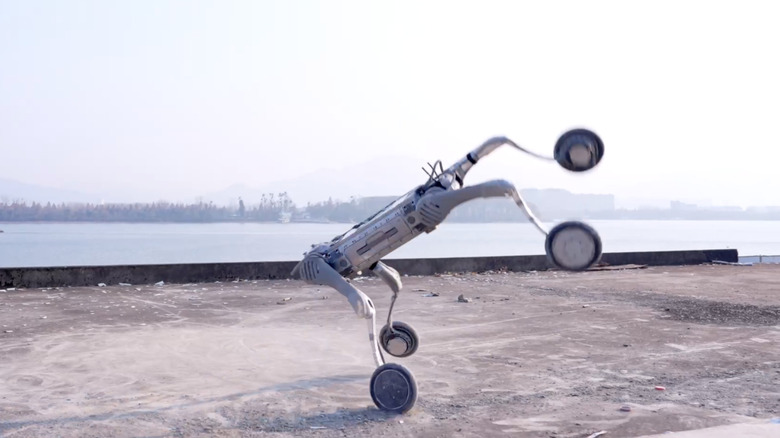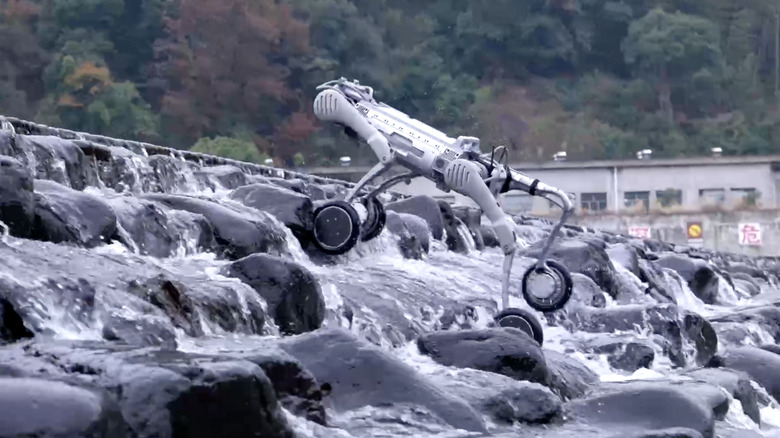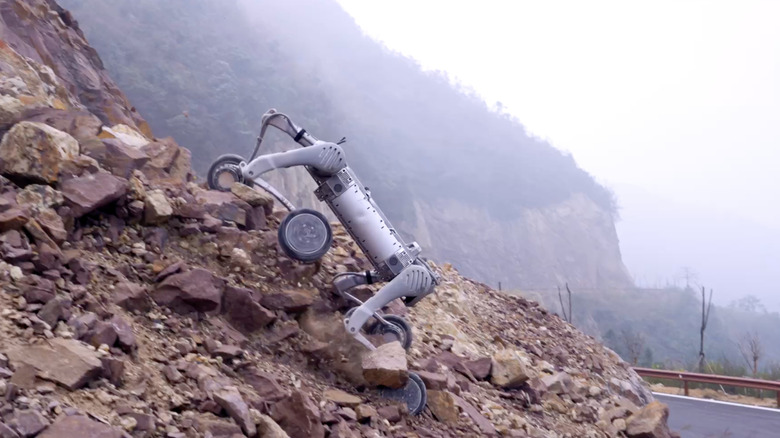This Emergency Rescue Robot Is A Real Parkour Master
When it comes to emergency response, there are a ton of barriers that even trained professionals need to overcome, such as being able to quickly reach the patient in the shortest amount of time possible. While some people get lucky, wherein there are trained first aid professionals or EMTs within reach, others are not, which means they'll need to wait until someone with medical knowledge or an emergency response background can assist them. For many emergency medical scenarios, like hemorrhages or airway obstruction, a National Library of Medicine study shares that there is often a critical 10-minute window. But even for other types of scenarios like those in the wild, such as a broken leg during a hike or getting stuck in the snow while snowboarding, it can cause a significant amount of distress to feel like a sitting duck.
Unfortunately, there may be moments when help needs more time to arrive, especially when difficult terrain is involved. In the past, this may even have led to unnecessary deaths, because the critical response window has passed. While it is possible to conduct emergency rescue in tough terrain, such as how the military has used helicopters to save wounded soldiers during real battle, this option isn't always available. Not to mention, they can be expensive for the average person if it is not covered by their insurance policies. Thankfully, with the development of super agile robots like the Unitree B2-W, these issues may become a thing of the past pretty soon.
What makes the Unitree B2-W special
According to Unitree, the B2-W can handle a breadth of different terrains from rocky, gravel surfaces, and uneven slopes, to forest or woodland areas with a ton of vegetation. Able to quickly go up and down sides of mountains, it can be incredibly useful for saving hikers, who have veered far off trails. In addition, it has shown the ability to navigate wet and slippery surfaces as well, including being able to go upstream through stones. With its wheels that can continuously climb stairs, it's equipped to work in more urban settings in more ways than one. For example, Unitree demonstrates how it can jump vertical heights, such as rooftops up to 2.8 meters, and maintain balance in the face of obstacles. Additionally, its high performance joint modules are built to withstand impact when landing on concrete.
That said, it's important to manage our expectations. Unitree specifically states that the B2-W is still a civilian robot, plus it has key limitations for rescue-related capabilities. For example, Unitree shares its maximum walking load to only be around 88 pounds, which is less than half the average adult American man's weight, for up to 15.5 miles. Not to mention, its operating temperature is listed only until -4 degrees Fahrenheit , which is not ideal for rescues in colder climates. But if there's ever a breakdance party emergency, the B2-W can quickly impress whoever is in the room with its 360 spin, whirlwind jumps, spinning handstand, and side flips.
How robots are increasingly part of our everyday life
Apart from rescue, robots are increasingly becoming irreplaceable components to almost every aspect of our lives, whether it is in our jobs, in school, on the battlefield, or even our homes. Robots are already performing important roles in existing military operations. In fact, there have been a slew of impressive military robots that have already graced real battle and have performed tasks that range from bomb disposal, tactical surveillance, to reconnaissance. But on the other end of the spectrum, there are also robots that work hand-in-hand with medical professionals. In the past decade, we've seen everything from robot-assisted spinal surgery to microbots delivering medicine to cancer cells. In many ways, we are only scratching the surface on what can be done with robotics in life-saving scenarios.
Similar to the Unitree robot, there are other more animal-like robots that perform the equally important task of providing both entertainment and emotional support. For decades little robots like Sony's Aibo have already become important companions for dog lovers, who may not be able to commit to owning real animals. With the leaps and bounds in artificial intelligence, it's likely that the upcoming robots are only going to feel more and more "real." If we ever reach the point in human history when the sci-fi movie "Terminator" becomes a prophecy, it wouldn't be so bad if our new robot overlords at least looked cute.


